How To Create A To-Do List In WordPress
 There is never enough time to get things done, especially if you run a fast-paced business.
There is never enough time to get things done, especially if you run a fast-paced business.
There is just so much work to do and things to remember. You have so many deadlines to meet, projects to complete, priorities to attend to, fires to put out, calls and appointments to make, commitments to keep and so on. The amount of things that need to get done never stops.
Now … on top of all this, add the extra workload of promoting and growing your business online and maintaining your website updated with regular content and everything can suddenly begin feeling unmanageable and out of control.
Whether you are running a business, website, blog, or managing a project, you need to be able to organize and prioritize your daily tasks, keep track of your progress, and, if necessary, delegate responsibilities to members of your team or staff effectively.
A simple proven method that can help you save time, create a sense of order and manageability, and allow you to take control is to use a “to do” list.
The Benefits Of Using To-Do Lists
A “to do” list can help you measure your progress when trying to get tasks completed. Your to-do list can be very detailed or specific, or act as a reminder of what needs to be done over a given period of time.
Here are just a few of the benefits of using to do lists:
Free The Brain
Creating to-do lists means you won’t have to try and remember stuff or store additional information inside your mind. Once things are jotted down on a to do list, your brain is free to process other information and you can focus on other areas that are more important.
Better Manage Your Time
Prioritizing tasks on your list helps you save time. You can develop a better perspective on what is truly urgent vs what is not, and what tasks have to be done first.
Keep Work Logs
To-do lists allow you to retain documented logs of what work has been done. This can be used to provide evidence of work done to clients or employers, or simply as a way of helping you measure your own productivity and efficiency.
Reduce Stress
Stress can result from feeling overwhelmed by so much to do and so little time to do it all in. Creating a to-do list allows you to prioritize important things that need to be completed within the time you have available, and push out tasks that can be addressed at a later time. This can help reduce stress.
Better Delegation
A to-do list helps you better delegate tasks to others. This is also important if you plan to collaborate with others (see further below).
As you can see, there are many benefits to using a to-do list, both in business and in your personal life. Creating a to-do list, then prioritizing tasks and working systematically improves efficiency and productivity in your business.
What about adding to do lists to your website or blog?
In this detailed tutorial you are going to learn how to add to do lists to a WordPress site to improve business efficiency and productivity using a great little WordPress plugin called Cleverness To-Do List.
Cleverness To-Do List
Cleverness To-Do List Plugin URL
http://wordpress.org/plugins/cleverness-to-do-list/
Plugin Description
This plugin provides users with a to do list feature.
Features
Note: the plugin features listed below will be discussed in more detail in the tutorial section.
You can set up the plugin to have private to do lists for individual users, to have all users share your to-do list, or to have a master list with individual item completions.
The shared to do list provides different settings. You can assign to-do items to specific users (this includes emailing a new to-do item to the assigned user) and optionally to have assigned items be seen by that user. You can also assign different permission levels using capabilities. There are also settings to display deadline and progress fields. Category support is included as well as front-end administration.
A new menu item is added to the admin backend to manage your lists and the to do list can also appear on a dashboard widget.
A sidebar widget is available as well as short code to display the to do list items on your blog. There are 2 shortcodes for front-end administration of your list. Management of categories is restricted to the back-end.
If you plan to set up a multi-author blog you can use this to-do lists plugin to create custom to-do lists for your post planners if you also download the developer’s premium plugin, Post Planner.
Plugin Installation
In your site’s dashboard, select Plugins > Add New …
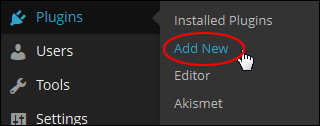
In the Install Plugins screen, type in “cleverness” into the search field and hit Enter on your keyboard …
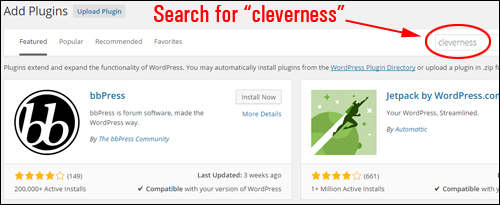
Locate the Cleverness To-Do List plugin in the Search Results tab and click Install Now …
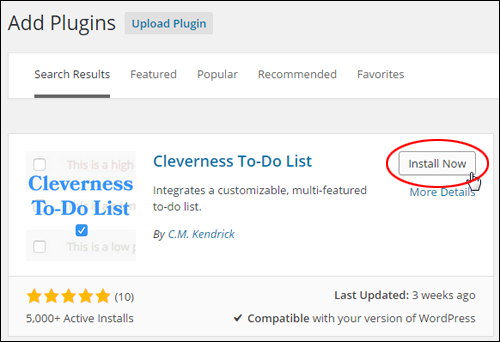
Click Activate Plugin …
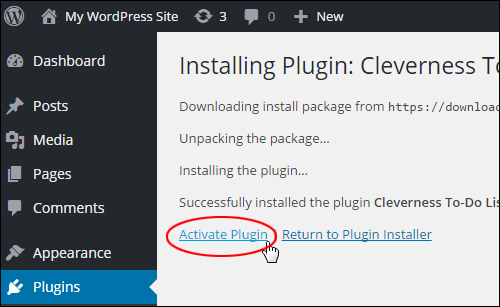
Note: You can also activate this plugin from the Plugins section …

When you have activated the plugin, click on Settings …

Note: You can also get to the plugin’s settings screen by choosing To-Do List > Settings from the dashboard menu …

This brings you to the ‘Settings’ area …

Let’s go through the plugin configuration process …
How To Set Up The Plugin
The Settings screen is divided into 4 tabs:
- To-Do List Settings – The options in this section let you specify the plugin’s main settings.
- Advanced Settings – The options in this area let you customize To Do lists, assign to-do items to other users and perform plugin database maintenance tasks.
- User Permissions – The options in this section let you configure user permissions and capabilities for Group and Master List types.
- Import/Export – This tab is where you can import and export your to-do list data and plugin settings.
Let’s now take you through each of these tabs.
To-Do List Settings
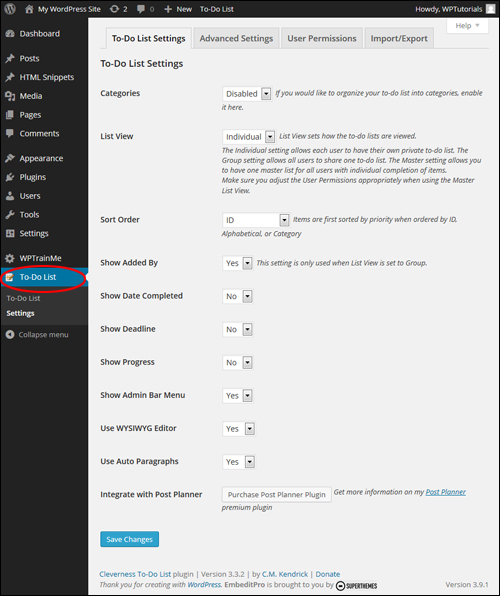
To-Do List Categories
Choose ‘Enabled’ to organize your to-do list into categories, otherwise leave this option set to ‘Disabled’.
Note: If you enable this option, a ‘Categories’ item gets added to the To-Do List plugin menu …
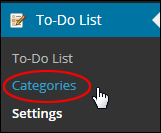
This lets you add categories that you can use to organize your to-do lists (see ‘Plugin Usage’ section further below for more details) …
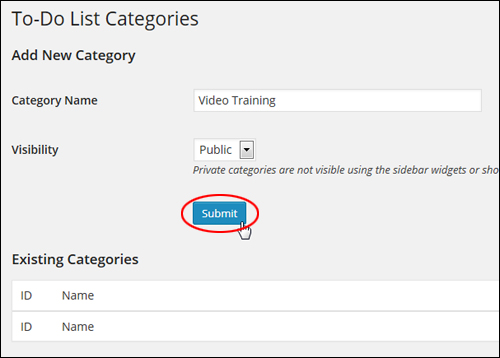
You can set up ‘public’ and ‘private’ categories for your lists.
Private categories will not be visible when using sidebar widgets or short codes (only when ‘Sort Order’ is set to ‘Category’)
List View
List View allows you to specify how to-do lists are viewed. You can choose 3 list views:
- Individual – Use this option if you want each user to be able to create and manage their own private to-do list.
- Group – Use this option if you want all users to be able to share the same to-do list.
- Master – This option allows you to create one master list for all users, where users have their own individual items to complete. If you choose the ‘Master’ list view, make sure to configure the User Permissions appropriately in the ‘User Permissions’ tab (this is covered further below).
Sort Order
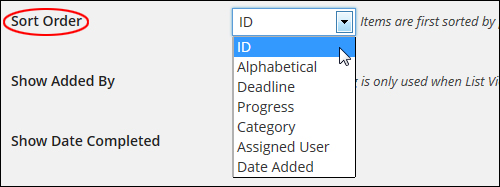
‘Sort Order’ lets you specify how to sort to-do list items.
If you choose ID, Alphabetical, or Category options, items will be first sorted by priority.
Show Added By
If this option is enabled, you can display which members on your site have added an item to the to-do list.
Note: This setting only applies if ‘List View’ is set to ‘Group’.
Show Date Completed
If this option is enabled, completion dates will display for to-do tasks.
Show Deadline
If this option is enabled, you can specify deadlines for your to-do tasks …
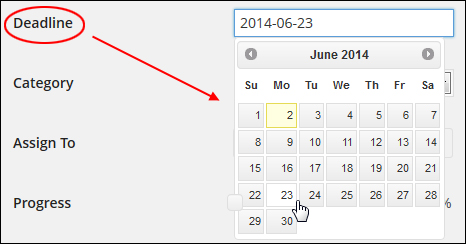
Show Progress
If this option is enabled (‘Yes’), you will be able to specify task progress indicators for your to-do items …

Show Admin Bar Menu
Enabling this option lets you display the ‘To-Do List’ menu in your WordPress Admin bar …

Use WYSIWYG Editor
If this option is enabled, you can add and edit items on your to-do list using the WordPress WYSIWYG Editor …
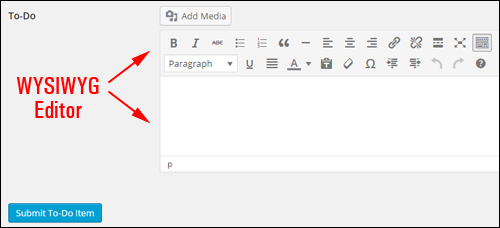
Use Auto Paragraphs
If enabled (‘Yes’), automatic paragraphs are used to display content in your to-do list items.
Integrate with Post Planner
If you plan to run a collaborative website or blog, you can integrate the Cleverness To Do List plugin with a plugin called WordPress Post Planner, developed by the same author that provides you with a complete WordPress editorial solution …
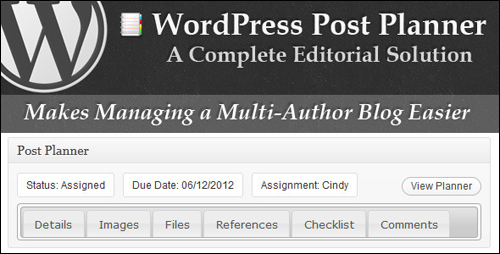
To learn more about using this handy plugin, visit this site: WordPress Post Planner
After configuring your options, click the ‘Save Changes’ button …

Advanced Settings
After you have configured the general settings, click on the ‘Advanced Settings’ tab to proceed …

This brings up the plugin’s ‘Advanced Settings’ area …
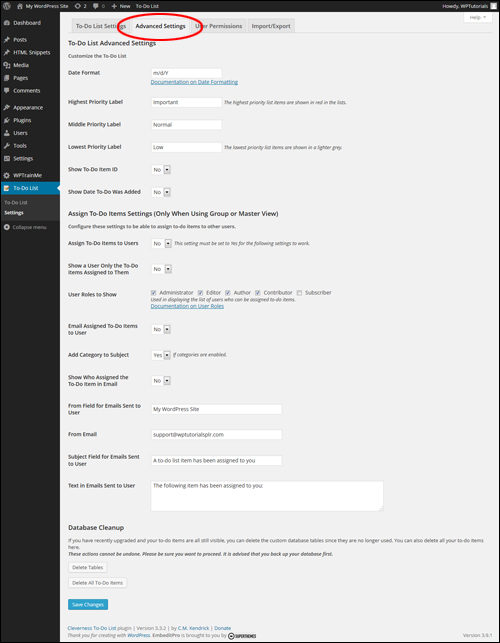
In this tab you can customize your To-Do lists, assign to-do tasks to users and carry out database maintenance.
Let’s take you through how to configure the plugin’s ‘Advanced Settings’ section …
To-Do List Advanced Settings > Customize The To-Do List
Here you can customize your To-Do List …
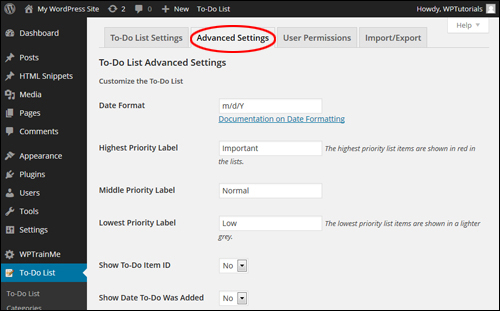
You can configure the following settings in this section:
Date Format
Here you can specify how to display dates in your to-do list (e.g. month/day/year, day/month/year, etc.)
Note: To learn more about formatting dates in WordPress, refer to the date section of the WordPress Codex below:
WordPress Codex – Formatting Date And Time
Priority Labels
This section lets you customize your labels for important, normal and lowest (low) priority items …

high priority items are colour-coded in red in the lists and lowest priority items display in a lighter shade of grey …
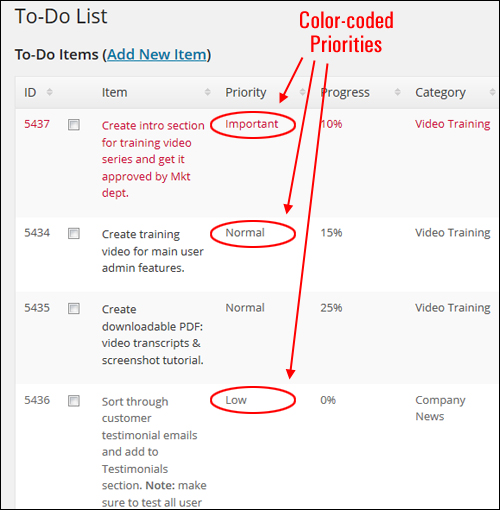
Show To-Do Item ID
Enabling this option (‘Yes’) will show the item’s ID on your list …
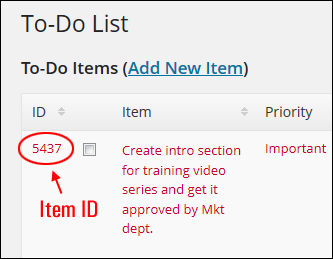
Show Date To-Do Was Added
Enabling this option (‘Yes’) displays the date the items table was added …
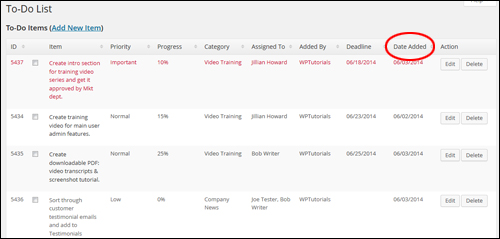
To-Do List Advanced Settings > Assign To-Do Items Settings
If you have selected either ‘Group’ or ‘Master’ View for your to-do list, you can configure the options in this area and assign to-do items to other users …
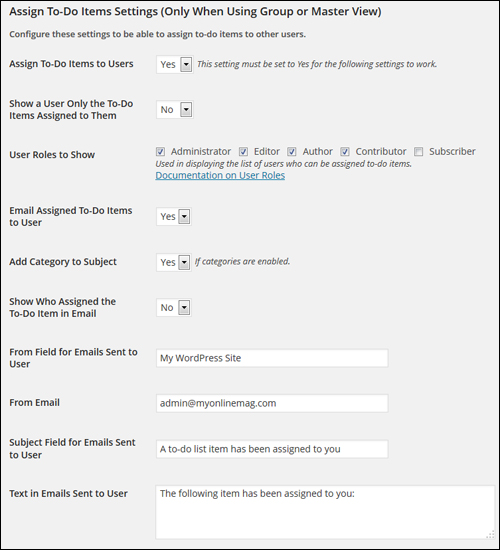
The following options can be configured in this area:
Assign To-Do Items to Users
Enable this option (‘Yes’) to assign to-do items to other users …
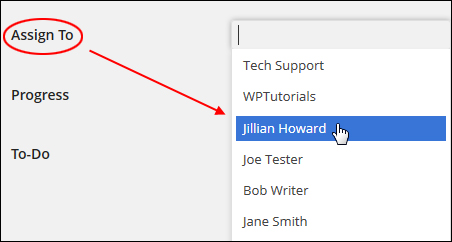
Note: This set this option to ‘Yes’ for the settings below it to work.
Show a User Only the To-Do Items Assigned to Them
Enabling this option displays to-do items only to users who have been specifically assigned those items. Leaving this option disabled (‘No’) will display items to all users.
User Roles to Show
Checking the boxes in this section Contributor displays the type of users that can be assigned to-do items. Leave the checkbox unticked for any roles that you don’t want to assign to-do items.
Email Assigned To-Do Items to User
When this option is enabled (‘Yes’), WordPress will automatically send an email to users with their assigned to-do items …
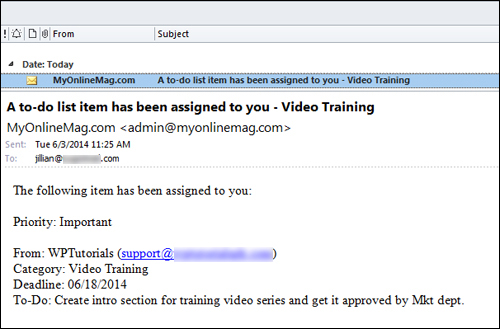
Leave this option disabled if you don’t want to send out emails to users.
Note: If you disable this option, you can skip the other settings in this section.
Add Category to Subject
If categories are enabled in your plugin settings and you have selected ‘Yes’ for this option, the to-do category will display on the subject of your emails …
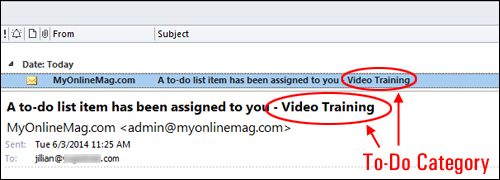
Leave this option disabled (‘No’) if you don’t want to-do categories to appear the subject of your emails.
Leave this option disabled if you don’t want categories to show the subject of your emails.
Show Who Assigned the To-Do Item in Email
Enable this option (‘Yes’) to display the user who assigned the to-do item in the email. This is a useful option if you have a number of project managers assigning to-do items to users …

From Field for Emails Sent to User
This field allows you to customize the “From” field when sending out email notices. Add your company name, your domain, your name, or anything you like into this field …

From Email
Type in the email address that you would like displayed as the “sent from” email address …

Subject Field for Emails Sent to User
Type into this field a subject field for the email that will be distributed automatically to users when new items have been added in your to-do list …

Text in Emails Sent to User
Type into this field the body of the email message that will be sent out automatically to users when a new item has been assigned to your to-do list.

To-Do List Advanced Settings > Database Cleanup
In this section you can perform database maintenance tasks related to plugin data inside the plugin settings area …

This is useful if, for example, you notice that items you have deleted are still showing on your site.
You can perform the tasks below in this section:
- Delete Tables – Delete any custom database tables that you no longer use.
- Delete All To-Do Items – Delete all to-do items.
![]()
Actions that you perform on the database from this screen cannot be undone. If you are comfortable to proceed with any of the database operations available in this section, then make sure to backup your WP database first.
If you don’t want to perform your own backups, then consider using a professional service, or use a backup plugin. You can read about a WordPress backup plugin that can fully automate your backup process here:
User Permissions
Here you can configure user permissions and capabilities for Group or Master List types …

![]()
If you select the Individual List type, the only setting that is applicable in this section is the View To-Do List permission …
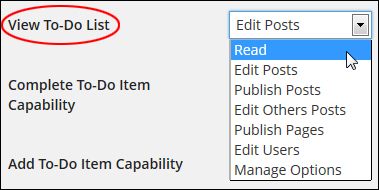
If you plan to set up user permissions and capabilities for Group or Master List types, select the highest level capabilities that you want users to have access to for each option …
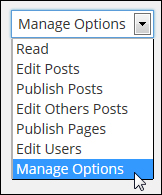
The default general capabilities for each user role are set as follows:
- Subscribers: Read
- Contributors: Edit Posts
- Authors: Publish Posts
- Editors: Edit Others Posts
- Administrators: Manage Options
Note: When working with the Master list type non-administrators should only be permitted to view and complete items, otherwise they will be able to edit the Master list itself.
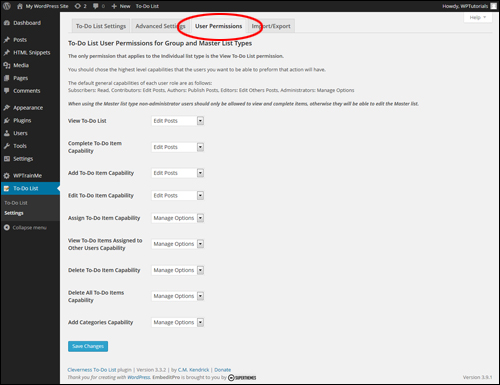
Let’s go through the settings in the User Permissions tab:
View To-Do List
Here you can enable the selected capability to view items in the dashboard widget and on the To-Do List page under the ‘Tools’ section.
Complete To-Do Item Capability
This permits the chosen capability to mark to-do items as completed or not completed.
Add To-Do Item Capability
This enables the chosen capability to add new items.
Edit To-Do Item Capability
This option allows the selected capability to modify existing to-do items.
Assign To-Do Item Capability
Here you can enable the chosen capability to delegate items to individual users.
View All Assigned Tasks Capability
This option enables the chosen capability to view all tasks even if “Show Each User Only Their Assigned Tasks” is set to ‘Yes’.
Delete To-Do Item Capability
Here you can permit the chosen capability to delete individual to-do items.
Delete All To-Do Items Capability
This option allows the selected capability to purge all the completed to-do items.
Add Categories Capability
Here you can allow the selected capability to add new categories.
Import/Export
Being able to import and export to-do list data can be useful. For example, you may want to transfer data from one site to another, or export your list data for backup or archiving purposes.
To access this function, click on the ‘Import/Export’ tab in your plugin settings area …

Use this section to easily import and export your data and plugin settings …
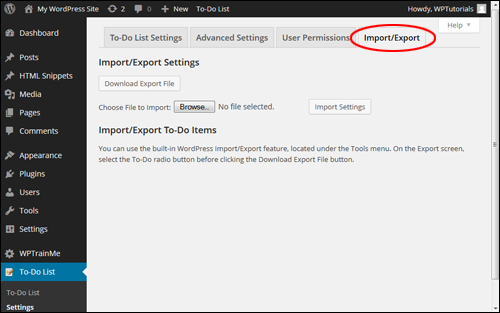
Exporting To-Do List Data
To export and download your list data settings click on the ‘Download Export File’ …

This opens up a window allowing you to download and save the data in a plain text file (e.g. Notepad) to a storage device …
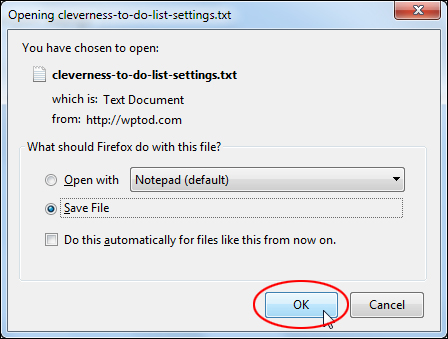
In addition to exporting list data from the ‘Import/Export’ section, you can also export data by going to your WordPress dashboard menu and choosing Tools > Export …
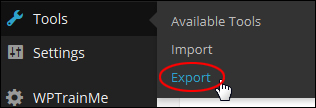
You can include to-do list data in an export file (in XML format), either by selecting ‘All content’ (includes everything – pages, posts, etc…), or just select ‘To-Do’ from the ‘Choose what to export’ section and click on the ‘Download Export File’ button to save your file to your hard drive…
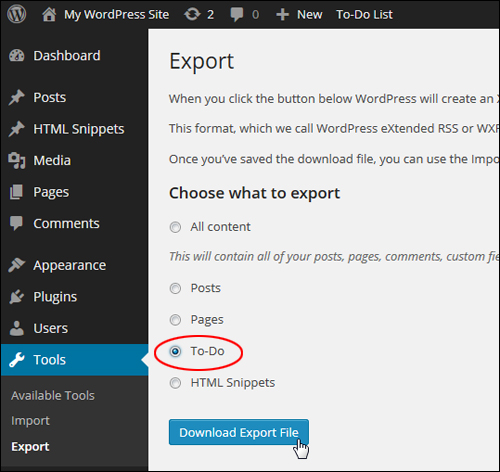
Importing To-Do List Data
Importing a list data file is easy. Just click on the ‘Browse’ button next to the ‘Choose File to Import’ field …

Select the previously saved to-do list data file in your hard drive or external drive and click ‘Open’ …
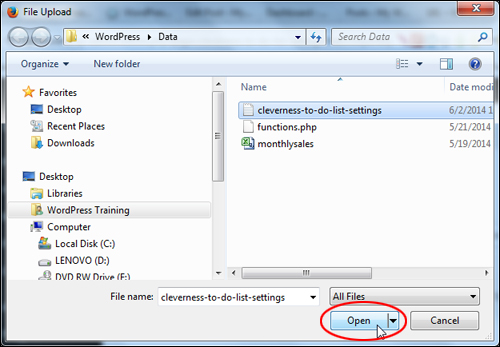
After uploading your data file, click the ‘Import Settings’ button …

Your file data will be imported.
Now that you have configured all of the plugin settings, you are ready to begin create and edit to do lists.
Plugin Usage
To create a new to-do list, log into your WordPress dashboard, then scroll down the menu and select To-Do List > To-Do List …
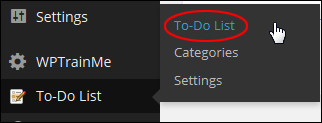
This brings you to the ‘To-Do List’ page …
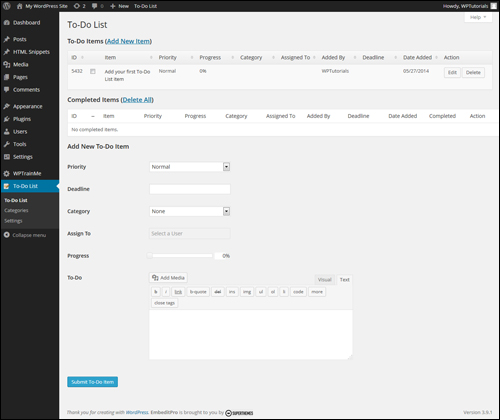
Add New Items To Your List
There are a number of ways to add new to-do items to your list.
For example, you can add a new item to your to-do list from your dashboard bar …

You can also add new items to your to-do list inside your Dashboard by clicking on the ‘Add To-Do item’ link …
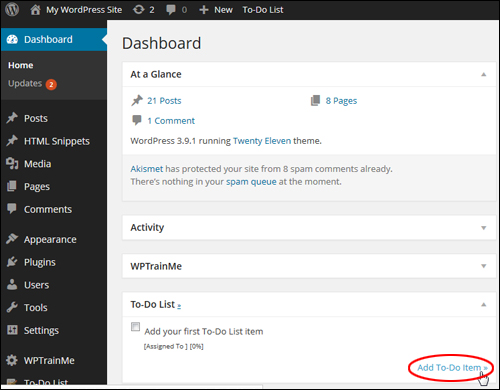
You can click on the ‘Add New Item’ link in the ‘To-Do Items’ section (note: only use this option if your To Do list already contains many items, since the link will simply take you to the “Add New To-Do Item” section down the page) …

The above methods will take you to the ‘Add New To-Do Item’ area.
Depending on how you have set up your plugin, some options may not display when adding new to-do items.
Configure the options you have enabled for your to-do items, enter appropriate values and information into the relevant fields and click on the ‘Submit To-Do Item’ button to add the to-do item …
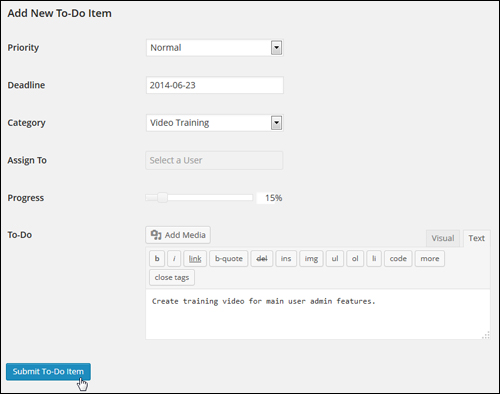
Note: If you are using a list type that allows you to assign responsibilities over items to users, select a user from the drop-down list and assign them the item …
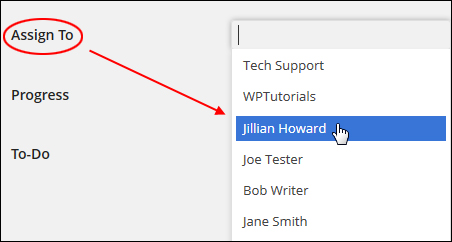
You can also assign items to multiple users (click on ‘x’ to delete users) …

After the new item has been added, it will be listed as an entry in the ‘To-Do Items’ table …

Repeat the above process to continue adding items to your to-do list …
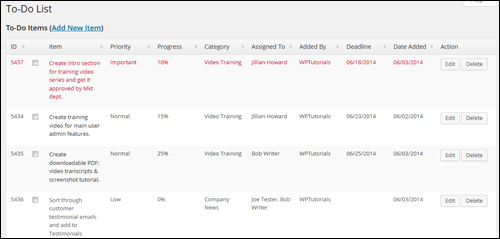
Edit And Remove Items From Your List
To edit or delete an item, click on the ‘Edit’ or ‘Delete’ buttons next to items under the ‘Action’ column …

Depending on how you have configured your plugin settings (see previous section), users assigned to completing tasks may also receive email notifications …
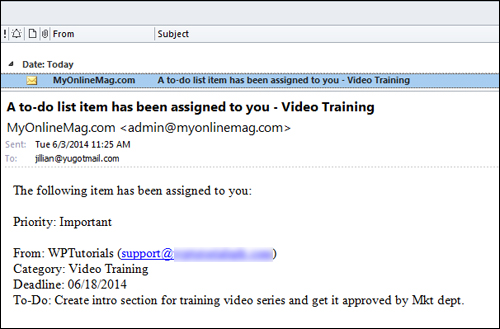
After creating your to-do list, users can view it from their WP user dashboard …
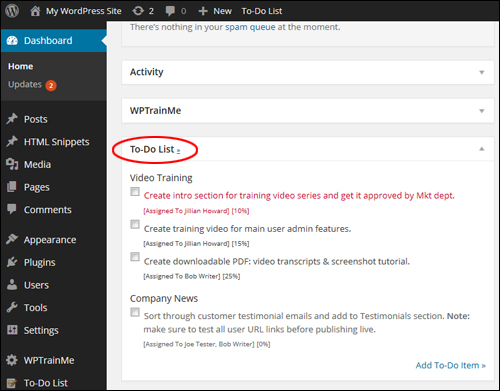
When users responsible for an item complete the task and click on the item check box …
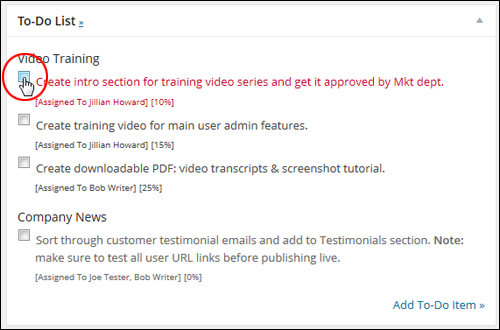
… the item is deleted from the “To-Do” list …
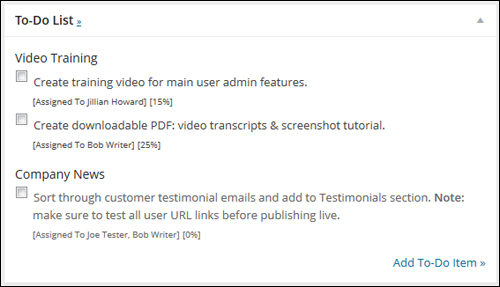
And gets listed the ‘Completed Items’ table located in the main screen of the ‘To-Do List’ plugin …

Additional Plugin Information
The Cleverness To-Do List plugin provides added functionality that lets you display to-do lists on your website using widgets, and display lists on content inside a page or post using shortcodes.
Plugin Widget
To add to-do lists to your site using widgets, go to the ‘Widgets’ page (Appearance > Widgets) and drag the ‘To-Do List’ widget to the location in your sidebar menu where you want your to-do list to appear …

Configure the settings in the widget and click on the ‘Save’ button …
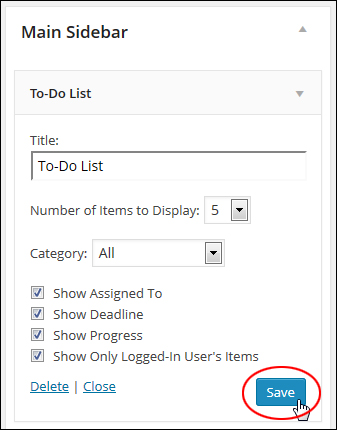
The to-do list will display wherever you have inserted the ‘to-do-list’ widget (e.g. the sidebar menu, footer, etc.)
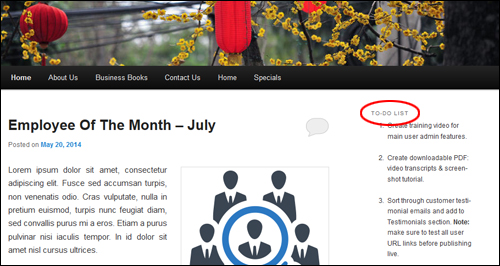
To learn more about using WordPress widgets, see the tutorial below:
Plugin Short Codes
You can also create lists and checklists to your site by placing short codes into your content.
To access the plugin’s short code documentation, click on To-Do List > To-Do List from the admin menu …
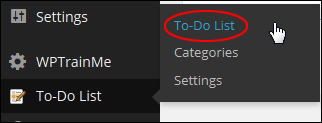
Click the ‘Help’ tab on the top right hand corner of your screen …
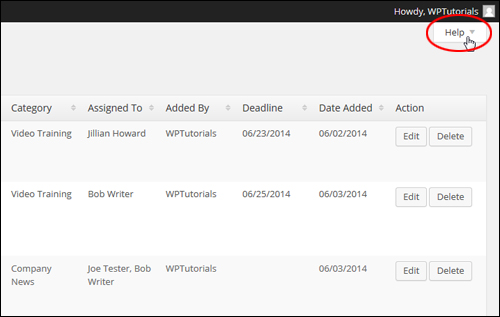
Click on the ‘Shortcodes’ menu to access the Shortcode Documentation section …
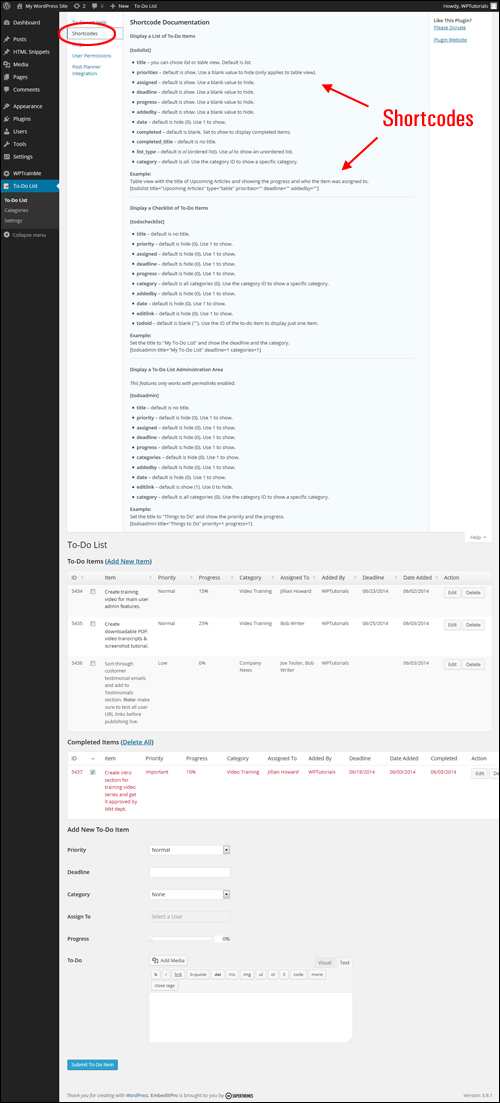
This section explains various ways to configure and use short codes to display lists on your posts and pages.
Once you know what information you would like to add to your site, create a new post or page and either type or paste the short code into the content editor …
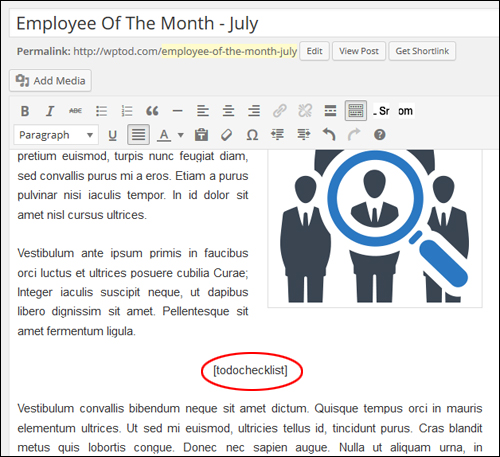
Publish your page or post and you will see the list showing in the location where you entered the shortcode …

Visit the plugin website here for more information about this plugin:
Congratulations! Now you can add to-do lists to your WordPress site.
***
"This is AMAZING! I had learnt about how to use WordPress previously, but this covers absolutely everything and more!! Incredible value! Thank you!" - Monique, Warrior Forum
***


